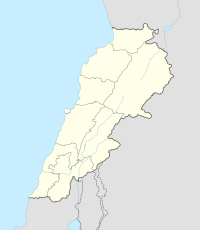Flaoui
Flaoui
فلاوي Fleywe | |
|---|---|
Village | |
 | |
| Country | |
| Governorate | Baalbek-Hermel |
| District | Baalbek |
| Elevation | 4,442 ft (1,354 m) |
| Alternative name | Fleywe |
|---|---|
| Location | 17 kilometres (11 mi) northwest of Baalbek, Lebanon |
| Coordinates | 34°05′00″N 36°03′00″E / 34.0833°N 36.0500°E |
| History | |
| Periods | Heavy Neolithic, Neolithic |
| Cultures | Qaraoun culture |
| Site notes | |
| Excavation dates | 1965 |
| Archaeologists | Frank Skeels, Lorraine Copeland |
| Public access | Yes |

Flaoui or Fleywe or Flaoueh (Arabic: فلاوي) is a small village located 17 kilometres (11 mi) northwest of Baalbek, Lebanon in Baalbek District, Baalbek-Hermel Governorate, Lebanon.[1] It is located near the north–south road that runs from Bodai to Chlifa.[2]
A Heavy Neolithic archaeological site of the Qaraoun culture is located in the area on fielded slopes of a small valley facing the Beqaa valley. It was discovered by Lorraine Copeland and Frank Skeels in 1965 with materials examined by Henri Fleisch. Worked tools were found made from abundant nodules of silicious, grey-yellow limestone. The material suggested to be Heavy Neolithic consisted of massive, rough cores and flakes with another group being found that showed resemblance to an assemblage termed by Fleisch the Micro-Mousterian. The site was under cultivation in 1966.[2]
References
- ^ Thom Sicking (1984). Religion et développement: étude comparée de deux villages libanais. Dar el-Machreq. Retrieved 5 September 2012.
- ^ a b L. Copeland; P. Wescombe (1966). Inventory of Stone-Age Sites in Lebanon: North, South and East-Central Lebanon, p. 30. Impr. Catholique. Retrieved 3 March 2011.
External links
- Flaoueh, Localiban
- Flaoui on www.tiptopglobe.com


